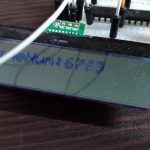カウントアッププログラム
前回はLCDのコマンドの操作方法を学びました。今回は、少しだけ実用的なカウントアッププログラムを書いていきます。
数字を文字列に変換する(sprintf関数)
まず、カウントアップした変数を文字列に変換しなければなりません。そこで、sprintf関数を使います。使い方は以下
int counter = 0;
char moji[] = '';
sprintf(moji,"hogehoge:%d",counter);
これで、mojiに「hogehoge:0」という文字列が保存されます。第一引数に文字をぶち込みたい配列のポインタ(変数名)、第二引数に文字列、第三引数に文字列内の%なんちゃらに代入したい変数名を入れます。
ただし、sprintf関数を使うには
#include <stdlib.h>
#include <stdio.h>
と、この二つのライブラリを読み込む必要があります。
カウントアップした文字をmojiにぶち込む
上のsprintf関数でもうお分かりかと思いますが、これをループ文で囲ってしまえば終了です。
while(1){
count++; //カウントアップ
sprintf(moji,"counter:%d",count); //mojiにcounter:countを代入
LCD_str(moji); //mojiを表示
}
これでLCDには”counter:0″から続いて”counter:1″…と表示される、と思ったら大間違いです。LCD_str()関数は前回の文字の最後からスタートするので、このまま実行するとこんな感じになります。
これを防ぐには、文字を入力してから左上の1文字目に戻る必要があります。これには、writeCommand(ToHome)を使います。このように修正しましょう。
while(1){
writeCommand(ToHome); //画面左上へカーソルを移動
count++; //カウントアップ
sprintf(moji,"counter:%d",count); //mojiにcounter:countを代入
LCD_str(moji); //mojiを表示
__delay_ms(1); //1ms遅延
}
これで、上手くカウントアップされるはずです。
完成プログラム
// PIC16F1938 Configuration Bit Settings
// 'C' source line config statements
// CONFIG1
#pragma config FOSC = INTOSC // Oscillator Selection (INTOSC oscillator: I/O function on CLKIN pin)
#pragma config WDTE = OFF // Watchdog Timer Enable (WDT disabled)
#pragma config PWRTE = OFF // Power-up Timer Enable (PWRT disabled)
#pragma config MCLRE = OFF // MCLR Pin Function Select (MCLR/VPP pin function is digital input)
#pragma config CP = OFF // Flash Program Memory Code Protection (Program memory code protection is disabled)
#pragma config CPD = OFF // Data Memory Code Protection (Data memory code protection is disabled)
#pragma config BOREN = OFF // Brown-out Reset Enable (Brown-out Reset disabled)
#pragma config CLKOUTEN = OFF // Clock Out Enable (CLKOUT function is disabled. I/O or oscillator function on the CLKOUT pin)
#pragma config IESO = OFF // Internal/External Switchover (Internal/External Switchover mode is disabled)
#pragma config FCMEN = OFF // Fail-Safe Clock Monitor Enable (Fail-Safe Clock Monitor is disabled)
// CONFIG2
#pragma config WRT = OFF // Flash Memory Self-Write Protection (Write protection off)
#pragma config VCAPEN = OFF // Voltage Regulator Capacitor Enable (All VCAP pin functionality is disabled)
#pragma config PLLEN = ON// PLL Enable (4x PLL disabled)
#pragma config STVREN = ON // Stack Overflow/Underflow Reset Enable (Stack Overflow or Underflow will cause a Reset)
#pragma config BORV = LO // Brown-out Reset Voltage Selection (Brown-out Reset Voltage (Vbor), low trip point selected.)
#pragma config LVP = ON // Low-Voltage Programming Enable (Low-voltage programming enabled)
// #pragma config statements should precede project file includes.
// Use project enums instead of #define for ON and OFF.
#include <xc.h>
#include <pic16f1938.h>
#include <stdlib.h>
#include <stdio.h>
#define _XTAL_FREQ 32000000
#define LCD_ADD 0x7C
#define ToHome 0b00000010
#define shiftLeft 0b00011000
#define shiftRight 0b00011100
#define clear 0b00000001
char moji[] = " ";
void I2C_Master_Init(const unsigned long c)
{
SSPCON1 = 0b00101000;
SSPCON2 = 0;
SSPADD = (_XTAL_FREQ/(4*c))-1;
SSPSTAT = 0b00000000 ; // 標準速度モードに設定する(100kHz)
}
void I2C_Master_Wait()
{
while ((SSPSTAT & 0x04) || (SSPCON2 & 0x1F));
}
void I2C_Master_Start()
{
I2C_Master_Wait();
SEN = 1;
}
void I2C_Master_RepeatedStart()
{
I2C_Master_Wait();
RSEN = 1;
}
void I2C_Master_Stop()
{
I2C_Master_Wait();
PEN = 1;
}
void I2C_Master_Write(unsigned d)
{
I2C_Master_Wait();
SSPBUF = d;
}
void writeData(char t_data){
I2C_Master_Start();
I2C_Master_Write(LCD_ADD);
I2C_Master_Write(0x40);
I2C_Master_Write(t_data);
I2C_Master_Stop();
__delay_ms(1);
}
void writeCommand(char t_command){
I2C_Master_Start();
I2C_Master_Write(LCD_ADD);
I2C_Master_Write(0x00);
I2C_Master_Write(t_command);
I2C_Master_Stop();
__delay_ms(10);
}
void PICinit(){
OSCCON = 0b01110000;
ANSELA = 0b00000000;
ANSELB = 0b00000000;
TRISA = 0b00000000;
TRISB = 0b00000000;
TRISC = 0b00011000;
PORTA = 0b00000000; //2進数で書いた場合
PORTB = 0x00; //16進数で書いた場合
}
void LCD_Init(){ //LCDの初期化
I2C_Master_Init(100000);
__delay_ms(400);
writeCommand(0x38);
__delay_ms(20);
writeCommand(0x39);
__delay_ms(20);
writeCommand(0x14);
__delay_ms(20);
writeCommand(0x73);
__delay_ms(20);
writeCommand(0x52);
__delay_ms(20);
writeCommand(0x6C);
__delay_ms(250);
writeCommand(0x38);
__delay_ms(20);
writeCommand(0x01);
__delay_ms(20);
writeCommand(0x0C);
__delay_ms(20);
}
void LCD_str(char *c) { //LCDに配列の文字を表示
unsigned char i,wk;
for (i=0 ; ; i++) {
wk = c[i];
if (wk == 0x00) {break;}
writeData(wk);
}
}
int main(void){
PICinit(); //PICを初期化
LCD_Init();
writeCommand(0x01); //画面をクリア
__delay_ms(20);
writeCommand(0x02); //ホームへカーソル移動
__delay_ms(2); // LCD側の処理待ち
int count = 0;
__delay_ms(1000);
while(1){
writeCommand(ToHome); //画面左上へカーソルを移動
count++; //カウントアップ
sprintf(moji,"counter:%d",count); //mojiにcounter:countを代入
LCD_str(moji); //mojiを表示
__delay_ms(1); //1ms遅延
}
return 0;
}
完成動画
これで、変数のLCDへの表示も完璧ですね。変化する文字列に関しても、sprintf関数内の%dを%sに変えれば対応できます。ぜひ、タイマーなどを作ってみて…とはいきません。__delay_ms(1000)にして1秒ごとにカウントアップしたつもりでも、実際はsprintfの変換にかかる時間や、LCDへコマンドを送る時間だけ遅れが生じてしまいます。
では、どうすれば正確な時間でカウントアップできるのでしょうか。これは、タイマー割り込みという機能を使うと実現できます。これに関してはまた後日記事を書きます。
次回は、RGBLEDを使って遊んでみましょう!



